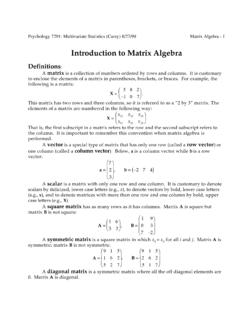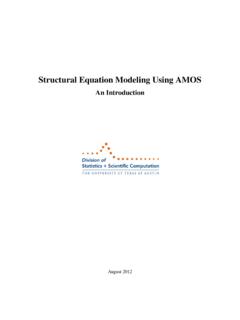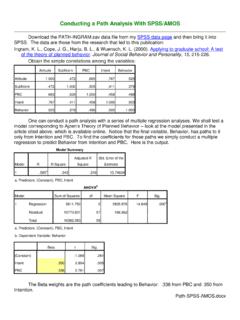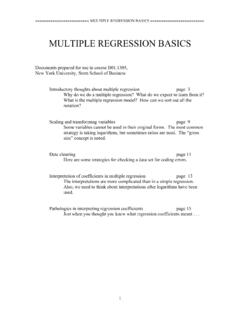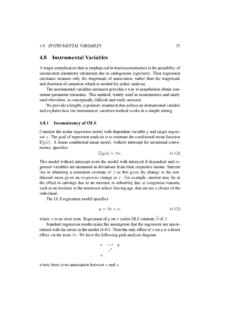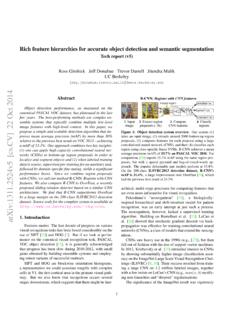Transcription of MULTIPLE REGRESSION AND PATH ANALYSIS
1 Gregory Carey, 1998 REGRESSION & path ANALYSIS - 1 MULTIPLE REGRESSION AND path ANALYSISI ntroductionPath ANALYSIS and MULTIPLE REGRESSION go hand in hand (almost). Also, it is easier to learnabout multivariate REGRESSION using path ANALYSIS than using algebra. We will start with anintuitive approach and later develop the algebraic the following SAS statements on the INTEREST data:LIBNAME carey '~carey/p7291dir';TITLE path ANALYSIS and Multivariate MULTIPLE REGRESSION ;PROC REG DATA= CORR;VAR lawyer architct educ vocab geometry;MODEL lawyer architct = educ vocab geometry / STB;MTEST / PRINT;This performs a MULTIPLE REGRESSION on two dependent variables, vocational interest in becoming alawyer (LAWYER) and vocational interest in becoming an (ARCHITCT). The independentvariables are education (EDUC) and two tests of cognitive ability, vocabulary (VOCAB) andgeometry (GEOMETRY). (Technically, it would be preferable to include other demographicssuch as gender and age in this ANALYSIS , but these variables are ignored here to keep matterssimple.)
2 The SAS program used for this example may be found on~carey/p7291 the output, which is attached to this handout, may be found on~carey/p7291 coefficients for path ANALYSIS may be expressed in either of two metrics. The firstmetric is called unstandardized, and it uses the measurement scale of the original variables. Here,paths are unstandardized REGRESSION coefficients, covariances link the independent variables, andthe purpose is to explain variance and covariance. The second metric is called standardized. Literally, this is the result of a path ANALYSIS or REGRESSION performed on all variables that havebeen transformed into standardized variables ( , with means of 0 and standard deviations ). In standardized units, the path coefficients equal the standardized REGRESSION coefficients( , the weights), and the purpose is to explain the proportions of variance and thecorrelations among variables. The following gives path ANALYSIS information using construct a path diagram, we require two pieces of information.
3 The first piece is thecorrelation matrix among the variables. This may be obtained by performing PROC CORR on thevariables or by specifying the CORR option on the PROC REG command. The second piece isthe vector of standardized REGRESSION coefficients. We got this by specifying the STB (forSTandardized Beta) on the MODEL subcommand for PROC the path ANALYSIS by writing down the independent variables and connecting each Gregory Carey, 1998 REGRESSION & path ANALYSIS - 2pair with a double headed arrow. Write the dependent variable. From each independent variable,draw a straight, single headed arrow shooting into the dependent variable. Finally, make anotation for a residual variable and draw an arrow from it into the dependent variable. Figure 1shows this path diagram for LAWYER. The residual in Figure 1 is denoted as 1. Setting up a path diagram for MULTIPLE second step is to place numbers on the arrows.
4 On the double headed arrows writedown the correlations between the independent variables. For example, the correlation betweenEDUC and VOCAB is .5182, so that number is written on the double headed arrow betweenEDUC and VOCAB. On the straight arrows, place the standardized (not the unstandardized) REGRESSION coefficients. These standardized REGRESSION coefficients are referred to as pathcoefficients. Finally, take the square root of (1 - R2) and place this value on the arrow going fromthe residual to the dependent variable. Performing all these operations gives Figure 2. Gregory Carey, 1998 REGRESSION & path ANALYSIS - 3 Figure 2. path model for variable utility of path ANALYSIS here is to decompose the sources of a correlation between anindependent variable and a dependent variable. That is, we can use the path diagram to uncoverwhy education, say, is correlated with (or predicts) interest in a legal 's consider the relationship between LAWYER and EDUC.
5 First, education has adirect effect on LAWYER1. This is depicted by the straight arrow going into LAWYER fromEDUC . The magnitude of this effect is quantified by the standardized REGRESSION coefficient, Second, education has two indirect effects. The first indirect effect arises becauseeducation is correlated with vocabulary and vocabulary directly predicts LAWYER. This isdepicted by the pathway starting from EDUC, going into VOCAB, and then exiting fromVOCAB directly into LAWYER. This indirect effect is quantified by the product of these twopaths. Thus, the indirect effect of EDUC going through VOCAB equals .5182(.3123) = . second indirect effects reflects the correlation between EDUC and GEOMETRY and thedirect effect of GEOMETRY on LAWYER. This is depicted by the pathway from EDUC toGEOMETRY and then the direct arrow from GEOMETRY to LAWYER. The magnitude of thisindirect effect is .4136*( ) = 1 The term "effect" is used in a noncausal or predictive sense.
6 Statistics themselves cannotdetermine causal relationships although they may aid in uncovering causal associations. Issues ofexperimental design and previous empirical research must always be considered. Gregory Carey, 1998 REGRESSION & path ANALYSIS - 4 Applied to MULTIPLE REGRESSION , the primary rule of path ANALYSIS states that thecorrelation between an independent and a dependent variable is the sum of the direct effect and allindirect effects. Thus, the correlation between EDUC and LAWYER equals .2409 + 5182(.3123)+ .4136*( ) = .2409 + .1618 + ( ) = .3942. Now look at the observed correlationbetween these two variables. You can verify that it, in fact, equals .3942 (within rounding error,of course). The advantage of examining the correlation between EDUC and LAWYER in thisway is that one can compare the direct with the indirect effects. In this case, EDUC predictsinterest in a legal career more strongly in a direct way (.)
7 2409) than it does in an indirect way(.1618 - .0085 = .1533).Going through the same procedure for VOCAB and LAWYER gives a direct effect , an indirect effect through EDUC of .5182(.2409) = .1248, and an indirect effect throughGEOMETRY of .6325( ) = Once again, the direct effect (.3123) is larger than theindirect effects (.1248 - .0129 = .1119).For GEOMETRY, the direct effect is , the indirect effect through EDUC (.2409) = .0996 and the indirect effect through VOCAB is .6325(.3123) = .1975. Thus, thecorrelation between GEOMETRY and LAWYER + .0996 + .1975 = .2767. Note herethat the total indirect effect (.0996 + .1975 = .2971) is stronger than the direct effect ( ).Thus, even though the observed correlation between GEOMETRY and LAWYER is significant,the path interpretation suggests that the correlation arises because GEOMETRY is correlatedwith other variables that have direct effects upon LAWYER, not because geometry itself directlypredicts 3 gives the path model for ARCHITCT.
8 You should be able to calculate the directand the indirect effects of the independent variables for this case. Gregory Carey, 1998 REGRESSION & path ANALYSIS - 5 Figure 3. path model for variable Tracing RulesAlthough we "intuited" the rules for path ANALYSIS above, there are formal tracing rules forcalculating the correlations for a path diagram. First, pick a variable to start. It can be either theindependent variable or the dependent variable. Then trace a route to the other variable,multiplying the coefficients when you go through two or more paths. Add together the results ofthese tracings for all the unique pathways. There are two exclusionary rules: (1) if you enter avariable on an arrowhead, you cannot exit on an arrowhead. Therefore, tracing from EDUC toVOCAB and then from VOCAB to GEOMETRY is illegal because we entered VOCAB on anarrowhead and exited VOCAB on an arrowhead. But tracing from LAWYER to EDUC and thenfrom EDUC to VOCAB is legal because we did not enter on EDUC on an arrowhead.
9 (2) in anysingle pathway, you cannot go through the same variable twice. This rule is mentioned here forcompleteness. One will not encounter cases in a MULTIPLE REGRESSION path model where one couldgo through the same variable MULTIPLE REGRESSION & path AnalysisAn astute person who examines the significance and values of the standardized betaweights and the correlations will quickly realize that interpretation through path ANALYSIS andinterpretation of these weights give the same substantive conclusions. The chief advantage ofpath ANALYSIS is seen when there are two or more dependent variables. Technically, this isreferred to as multivariate MULTIPLE REGRESSION . Here path ANALYSIS decomposes the sources of thecorrelations among the dependent variables. For the present example, we use path ANALYSIS to Gregory Carey, 1998 REGRESSION & path ANALYSIS - 6answer the following question: Why are interests in being a lawyer and an architect correlated?
10 The first task is to draw the path diagram. This is actually very easy if the diagrams forthe single dependent variables have already been drawn. The multivariate REGRESSION diagram isalmost the two single diagrams "superimposed" on one another. The correlations among theindependent variables remain the same and path coefficient that goes from any independentvariable into any dependent variable is simply the standardized REGRESSION coefficient for theindependent variable from the single MULTIPLE REGRESSION . The only other thing to do is to drawdouble headed arrows connecting each pair of residuals in the multivariate 4 shows the multivariate diagram for the example. Note how the path coefficientsfor LAWYER are the same as those in Figure 2 and the coefficients for ARCHTCT are the sameas those in Figure 3. Note also that the residual for LAWYER is correlated with the residual 4. Multivariate REGRESSION between LAWYER and ARCHTCT expressed as a only missing quantity in Figure 4 is the correlation between UL and UA or betweenthe residual for LAWYER and ARCHTCT.


